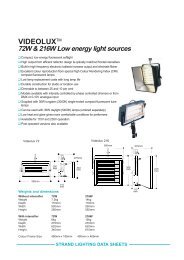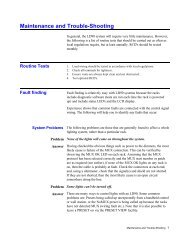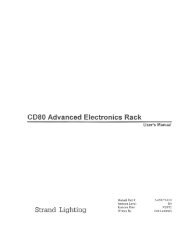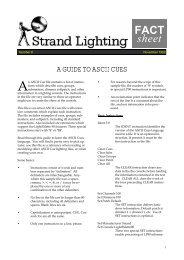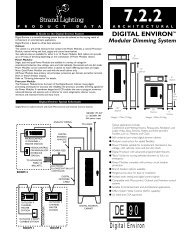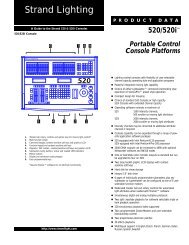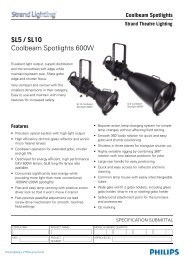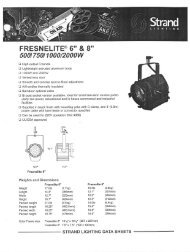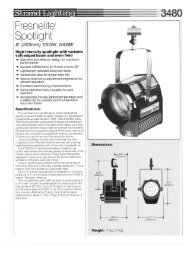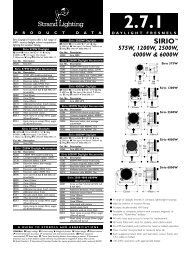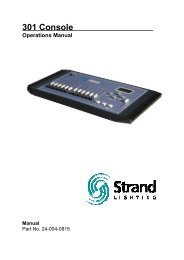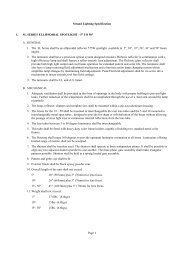STM Installation & Maintenance Manual now available for direct ...
STM Installation & Maintenance Manual now available for direct ...
STM Installation & Maintenance Manual now available for direct ...
You also want an ePaper? Increase the reach of your titles
YUMPU automatically turns print PDFs into web optimized ePapers that Google loves.
TECHNICALIMAINTENANCE<br />
HANDBOOK<br />
<strong>STM</strong> 10120 WAY INSTALLATIONS<br />
Page<br />
1. General In<strong>for</strong>mation<br />
1.1. Equipment<br />
2. Construction and Layout<br />
2.1. Racks<br />
2.2. Dimmer Modules<br />
L<br />
3. <strong>Installation</strong> and Connections<br />
3.1. <strong>Installation</strong><br />
3.2. Ventilation<br />
3.3. Mounting<br />
3.4. Connections<br />
4. Rack <strong>Maintenance</strong><br />
4.1. Rack Circuit Details<br />
4.2. Check and Test Procedure<br />
4.3. Dismantling/Replacement In<strong>for</strong>mation<br />
4.4. Routine <strong>Maintenance</strong><br />
4.5. Fans<br />
4.6. Fault Diagnosis<br />
L<br />
Appendix 'A1 <strong>STM</strong> Open Loop Modules <strong>Maintenance</strong><br />
A.1. Module Sizes<br />
A.2. Circuit Description<br />
A.3. Dismantling/Replacernent In<strong>for</strong>mation<br />
A.4. Check and Test Procedures<br />
A.5. Fault Diagnosis<br />
Supplements<br />
1105 - Series 'St Law Trigger Cards<br />
or<br />
1114 - Series Square Law Trigger Cards<br />
List of Regional Offices and Associate Companies<br />
7708 Issue 2
L. d r<br />
S Th<br />
rar<br />
to<br />
stc<br />
Rac<br />
Eac<br />
f UE<br />
',L<br />
MODULE TYPE<br />
* **<br />
KW<br />
2/2RKW <strong>STM</strong> 20 <strong>STM</strong> 25C<br />
RATING<br />
5KW<br />
<strong>STM</strong> 50C<br />
CIRCUIT<br />
RATING<br />
10A<br />
20A<br />
* : With laminated-core filter unit.<br />
** : With C-core filter unit.<br />
Issue 2 7708
<strong>STM</strong>/T/M<br />
2. CONSTRUCTION AND LAYOUT<br />
2.1 Racks (see Fig, 2.1 Page No. 16).<br />
The racks are of totally enclosed construction, designed<br />
<strong>for</strong> installation as free standing units. An integral<br />
bracket with holes is provided at the top of each rack<br />
to facilitate securing to a wall or vertical surface;<br />
alternatively two similar racks may be mounted back-toback<br />
and secured to each other. The fuse-panel is<br />
hinged to provide access to the terminal compartment.<br />
The Dimmer Modules are mounted in the remaining part of<br />
the rack in columns (of 3 and 7 in <strong>STM</strong>-10 racks), and<br />
metal panels secured by screws provide access <strong>for</strong><br />
maintenance purposes.<br />
Note: Some module positions may contain "Non-dim"<br />
Blank Panels,<br />
Rack (S) containing the following module combinations<br />
are fitted with a fan to assist internal ventilation;<br />
1) More than 50% <strong>STM</strong> 25C modules.<br />
2) More than 3 <strong>STM</strong> 50C modules in a rack, (2 in a 10 way<br />
rack) when the rack is otherwise full of <strong>STM</strong> 20<br />
modules.<br />
m<br />
In this case, there must not be more than<br />
1 <strong>STM</strong> 50C module per column.<br />
Air entry is via a grille at the bottom of the rack<br />
front panel.<br />
2.2 Dimmer Modules<br />
The Ref. Number <strong>for</strong> the module Is shown on a label<br />
affixed to the base-plate. Letter-suffix C to the<br />
Ref. Number indicates that the fi-lter unit is of C-core<br />
design.<br />
On modules with Plug-i.n Trigger cards, the plug-in<br />
connector is mounted on top of the heat-sinks.<br />
7708 Issue 2
Note: Each rack or group of racks is supplied with a R ef.<br />
855 Suppressor Unit consisting of four capacitors.<br />
Mount this unit close to the incoming mains-supply<br />
busbars; see Fig. 2.2 (Page No. 17) <strong>for</strong> dimensions<br />
and paragraph 3.4.2a <strong>for</strong> connections.<br />
3.1 <strong>Installation</strong> ---<br />
To minimise expensive cable-runs to the lamp loads,<br />
site the racks as near to the loads as practicable.<br />
There possible, group two or more racks together at<br />
one location. Avoid any accoustically 'livet<br />
position in the acting or audience area, since the<br />
racks are not completely silent in operation.<br />
An adequately fused isolator <strong>for</strong> the incoming mains-<br />
supply must be provided, preferably one near to each<br />
rack. The spare label reading 'High Voltage<br />
Insulation Testers Not To Be Used On This Equipment',<br />
provided with the rack(s), should be fixed to the main<br />
isolator switch. In choosing the location <strong>for</strong><br />
individual or grouped racks, ensure that free flow of<br />
air through each rack (air-inlet at bottom and outlet<br />
at top) is not impeded in any way. Also allow enough<br />
clearance to the left of the rack to allow the fuse<br />
panel to be hinged open more than 90° and permit free<br />
access to the terminals.<br />
3.2 Ventilation<br />
The <strong>for</strong>ced ventilation or natural convection in each<br />
rack is adequate to disperse the heat dissipated in<br />
the rack (less than 23% of maximum load or supply KW<br />
rating, whichever is the smaller), so long as the<br />
inlet air temperature does not exceed 35O~<br />
(95'~).<br />
Air conditioning equipment may be necessary in some<br />
locations to naintain the ambient temperature below<br />
Issue 2 7705
3.3 Mounting<br />
See figures 2.1 and 2.2 (Page<br />
fixing-hole dimensions.<br />
Where racks are grouped, it W<br />
to arrange them in the correc<br />
channel is numerically identi<br />
in sequence throughout the in<br />
3.4 Connections<br />
The channel identification nu<br />
connections to lamps loads, a<br />
and also <strong>for</strong> plotting cues an<br />
Note:<br />
Do not use high-voltag<br />
check wiring associated with<br />
Racks,<br />
3.4.1 Access to Terminals in<br />
Hinge open the fuse panel to gain access to<br />
incoming-supply busbars, the load terminals<br />
and control-wiring connections. A removable<br />
panel is provided on top of the rack to<br />
facilitate cable-entry.<br />
Note:<br />
Do not remove the panels covering the rest of<br />
the cabinet except <strong>for</strong> access to Dimmer Module<br />
<strong>for</strong> <strong>Maintenance</strong>.<br />
7708 Issue 2
Page 6<br />
3.4.2 Incoming-Supply Connections<br />
3.4.2a<br />
Suppressor Unit<br />
Rack(s) with 'c' type modules (<strong>STM</strong> 25/C,<br />
<strong>STM</strong> 50/C), a single Ref. 855 Suppressor<br />
Unit must be connected across the main<br />
supply intake as detailed in Fig. 3.4.<br />
(Page No. 18).<br />
Rack(s) without the benefit of 'c' type<br />
filter modules (<strong>STM</strong> 20) require two Ref.<br />
855 Suppressor Units, connected in<br />
parallel across the supply intake.<br />
Note:<br />
That the common terminal of the Suppressor<br />
Unit capacitors is taken to the Neutral<br />
Line. Local electricity authority<br />
regulations may require the suppressor<br />
unit to be separately fused on each phase.<br />
On single-phase systems (Phase, Neutral and<br />
Earth only), two of the capacitors in the<br />
suppressor unit are not used.<br />
3.4.2b<br />
Racks<br />
The Busbars behind the fuse panel are designed<br />
and adequately rated <strong>for</strong> the appropriate cablesizes<br />
to be used.<br />
4<br />
In the case of 3-phase applications, the Dimmer<br />
Module input supplies are internally connected<br />
in Phase sequence Red (Bar P1) to 1, 4, 7,<br />
etc. Yellow (Bar P2) to 2, 5, 8, etc. Blue<br />
(Bar P3) to 3, 6, 9, etc. unless otherwise<br />
specified by the user.<br />
It is imperative to provide an adequate earth/<br />
ground conductor <strong>for</strong> the external wiring and<br />
connect it to the earth/ground busbar E in the<br />
rack. Do not rely on earthing via conduit or<br />
trunking.<br />
Issue 2 7708
<strong>STM</strong>/T/M Page 7<br />
3.4.3 'Load1 Connections<br />
!Load1 and 'Neutral1 terminals are numbered to<br />
correspond with the Dimmer Modules.<br />
Since control<br />
of the output to the load involves wave<strong>for</strong>mswitching,<br />
the two conductors to each channel -<br />
load must be run as a pair of adjacent and equal-<br />
length conductors; this will ensure that each<br />
conductor in the pair carries equal and opposite<br />
current components.<br />
If a patching panel or other<br />
<strong>for</strong>m of load-selection unit is used, divert the<br />
conductors as a pair t o and from this unit.<br />
of care in this respect may result in strong<br />
Lack<br />
induced field tending to vibrate the cable-trunking<br />
or radiate interference.<br />
If armoured or metallic conduited cables with<br />
adequate earthing of the sheaths are not used,<br />
separate earth conductors are necessary and should<br />
be connected to earth-bar E in the racks.<br />
7708 Issue 2
Issue 2 7702
<strong>STM</strong>/T/M Page 9<br />
3.3.4b<br />
Control-Signal Connections<br />
Use terminals 1 to 10 (or 20) and<br />
'01 v<br />
terminal block. Since the wiring nas to carry less<br />
than 24V at a few mA, any suitable multi-conductor<br />
cable can be used subject to local authority<br />
regulations. A suitable cable (Rank Strand Electric<br />
code 35 601 11) is a 12-conductor or 0.5 sq. mm.,<br />
(16/0.2) PVC-insulated and sheathed cable, to be used<br />
one cable per each 10 channels. This cable has the<br />
advantage of 250V-grade insulation and does not have<br />
to be segregated from mains-voltage conductors.<br />
Connect each numbered terminal to the appr-upr-iate<br />
numbered terminal(from the channel lever potentiometer<br />
circuits) on the associated Desk or Panel;<br />
connect the common return line to Terminal C.<br />
Using the above 12-conductor cable, a consistent<br />
sequence of connecting conductors to numbered<br />
terminals (e.g. whfte, slate, brown, red, red/blue,<br />
redlwhite, pink, orange, yellow, blue, violet and<br />
black) will facilitate channel identification <strong>for</strong><br />
maintenance purposes at a later date.<br />
3.4.5 Other In<strong>for</strong>mation<br />
When all connections have been made to a rack,<br />
remove all cable-ends and other debris from the<br />
terminal compartment; check all connections carefully,<br />
especially to ensure that insulation is<br />
not trapped in the pressure-pad terminals; close<br />
the fuse panels.<br />
7708 Issue 2
3.4.5a<br />
Lamp-Loads<br />
The Dimmers are designed to control tungsten-load<br />
of the same voltage rating as the mains-supply.<br />
Each channel-dimmer requires a minimum load of 150W<br />
<strong>for</strong> satisfactory operation; hence smaller test-lamps<br />
or neon indicators should not be used as entire loads.<br />
The Dimmers will also control trans<strong>for</strong>mer-fed loads<br />
provided the load on the Dimmer is in excess of 300<br />
watts, either due to trans<strong>for</strong>mers secondary loads or<br />
some other ballast. Trans<strong>for</strong>mers must be individually<br />
fused, and situations such as one trans<strong>for</strong>mer feeding<br />
one tungsten lamp load with no other ballast avoided,<br />
since if this lamp failed, the Dimmer would be<br />
subjected to an unloaded trans<strong>for</strong>mer load (i.e. a load<br />
under 300 watts). Allowance must be made <strong>for</strong> the<br />
trans<strong>for</strong>mer magnetizing current when calculating the<br />
load current. The maximum c~ntinuous current rating<br />
of the Dimmers <strong>for</strong> this purpose is 10 amps (2/24KW) or<br />
20 amps ( 5KW 1.<br />
4<br />
3.4.5b<br />
Load-Line Terminations<br />
These should preferably be to socket outlets' numbered<br />
to correspond with the channel identification numbers,<br />
and <strong>for</strong> the flexibility usually required of stage and<br />
studio lighting, a standard socket. outlet should be 2<br />
adopted where possible.<br />
In the United Kingdom, 15 amp, 3-pin BS546 outlets are<br />
used in most installations. For high-wattage loads<br />
requiring outlets of more than 15A rating, suitably<br />
rated receptacles must be used, 32 amp connectors to<br />
CEE. 17 are suggested.<br />
For applications in countries other than the UK, local<br />
practices or regulations must prevail.<br />
Issue 2 7708
<strong>STM</strong>/T/M Page 11<br />
3.4.5~ Associated Sound System <strong>Installation</strong>s<br />
Wave<strong>for</strong>m switching, such as provided by thyristor<br />
Dimmers, can reveal, in the <strong>for</strong>m of spurious<br />
interference, previously unsuspected earth-loops in<br />
the associated sound-system installations. Careful<br />
inspection of sound-system earthing, screening, etc.<br />
may be necessary to remedy any earth loops.<br />
High impedance microphone lines are also susceptible<br />
to the pick-up of switching 'noise' from lampcircuits;<br />
low impedance balanced lines such as those<br />
used <strong>for</strong> moving-coil microphones are most suitable,<br />
especially if long audio cable-runs are necessary.<br />
3.4.5d<br />
Other Connections<br />
Do not connect or operate flash boxes or similar<br />
pyrotechnic devices (or any appliance liable to<br />
absorb surges of excessive power from the mainssupply)<br />
from the Dimmer or associated load circuits.<br />
Operate such devices separately from the mainssupply,<br />
under local (not remote) control by someone<br />
near the device and with a <strong>direct</strong> view of it.<br />
7708 Issue 2
Page 12<br />
<strong>STM</strong>/T/M<br />
4. RACK MAINTENANCE<br />
Circuit descriptions and <strong>Maintenance</strong> in<strong>for</strong>mation <strong>for</strong> the<br />
modules and trigger cards are contained in a separate<br />
appendix according to the dimmers supplied with the racks.<br />
4.1 Rack Circuit Details<br />
Racks can be wired <strong>for</strong> either star operation (Fig.<br />
4.1.1 Page No. 19) or <strong>for</strong> Delta operation (Fig. 4.1.2<br />
Page No. 20).<br />
4.1.1 Star Connected Rack<br />
Any module in a rack can be wired on to any phase.<br />
This is specified at the time of manufacture.<br />
The supply <strong>for</strong> each module is taken from the<br />
appropriate busbar and sent via the module fuse<br />
to the phase connection on the module. The<br />
neutrals <strong>for</strong> the modules are linked together in<br />
columns.<br />
d'<br />
The load connections to the modules go <strong>direct</strong> to<br />
the load terminal rail, as do the control<br />
connections to the modules. The technical earth<br />
connections <strong>for</strong> the modules are linked in columns.<br />
On some installations, the technical earth/mains<br />
earth link fitted on the control terminal block, 4<br />
may be removed if this link is made elsewhere in<br />
the system.<br />
4.1.2 Delta Connected Racks<br />
These are similar to Star connected racks, except<br />
that the "returns" to the modules and loads are<br />
individually fused, and routed to the modules<br />
separately.<br />
Issue 2 7708
<strong>STM</strong>II/T/M Page 13<br />
4.2 Check and Test Procedure<br />
Check that the a.c. supply to the rack is switched on:<br />
note that the neon on the fuse panel indicates the<br />
presence of an a.c. supply on the control and fan (if<br />
fitted) supply. Failure of the control fuse will<br />
cause the neon to extinguish. With the fuse panel<br />
hinged open, check that the fuse holder terminals are<br />
'live'. If a fan is fitted to the rack ensure that it<br />
is operating correctly. A i r should be blown OUT through<br />
the top of the rack.<br />
4.3 Dismantling/Replacement In<strong>for</strong>mation<br />
The electrical connections are made via a pressure pad<br />
terminal block. The five wires into the module should<br />
be disconnected be<strong>for</strong>e attempting to remove the module.<br />
The module is secured to the rack by four nuts that<br />
screw on to studs in the rack that pass through holes<br />
in the module base plate.<br />
7708 Issue 2
Routine <strong>Maintenance</strong><br />
Note:<br />
Only a qualified electrician familiar with the<br />
equipment should undertake replacement or other mainten-<br />
ance work in the racks.<br />
Always switch off the supply to the rack be<strong>for</strong>e under-<br />
taking any maintenance work.<br />
Remember that the thyristor<br />
heatsinks are at mains potential and take suitable<br />
precautions when testing and measuring with the supply<br />
switched on.<br />
The racks require little routine maintenance apart from<br />
attention to the fan if fitted. A periodical inspection 4<br />
of the rack's associated wiring and connections is<br />
recommended and, in very dust prone environments, inspect<br />
the rack interior <strong>for</strong> any accumulation of dust; use a<br />
soft brush and a vacuum cleaner to remove any accumulated<br />
dust.<br />
4.5 Fans<br />
The fan manufacturers advise that the fans used have<br />
sealed lubrication <strong>for</strong> the bearings and t his is normally<br />
adequate <strong>for</strong> 10,000 hrs operating time. Contact the<br />
Rank Strand Service department at the end of this period<br />
-<br />
<strong>for</strong> bearing replacement.<br />
Issue 2 7708
4.6 Fault Diagnosis<br />
Failure of a.c. supply to associated Desk and<br />
Indicator neon (and fan if fitted): Check<br />
'Controlt fuse.<br />
Complete failure of power to a module: Check<br />
the module fuse in the fuse panel.<br />
No output from a dimmer module but power supplied<br />
to module: Replace the dimmer module as a<br />
complete unit. Set up the new module as described<br />
in the appropriate appendix of the handbook.<br />
7708 Issue 2
Issue 2
OVERALL DIMENSIONS A- 197 mm (7.75")<br />
6- 24Zmm (9.5")<br />
C- 73 rnm(2-87")<br />
FIXING DIE R.E SUPPRESSOF ? UNIT REF 855<br />
Fig. 2.2
Issue 2
Page 19<br />
Issue 2
Page 20<br />
Issue 2
.P<br />
<strong>STM</strong>/T/M Page 21<br />
APPENDIX 'A' <strong>STM</strong> OPEN LOOP MODULES MAINTZNANCE<br />
A.l<br />
Module Size<br />
<strong>STM</strong> 20<br />
<strong>STM</strong> 25C<br />
<strong>STM</strong> 50C<br />
A.2 Circuit Descrk~tion Fig. A.2 (Page No. 25)<br />
A.2.P<br />
Principle of Operation<br />
An inverse-parallel connected pair of thyristors<br />
5CR1 and SCR2 are supplied with firing pulses from<br />
the trigger card such that each thyristor is switched<br />
on at the same relative instant during the appropriate<br />
half cycle of the mains. The value of the control<br />
signal into the trigger card determines the firing<br />
instant, hence determining the RMS output<br />
presented to the load,<br />
A.2.2<br />
Circuit Descriotion<br />
The control signal to the dimmer is applie<br />
terminals D and E on the module terminal b<br />
connections 3 and 5 on the trigger card.<br />
control signal is normally derived from a<br />
via one diode and a 10k ohm resistor. Thi<br />
with some older control systems.<br />
Terminal D is negative with respect to E (<br />
earth). Full output of the dimmer occurs<br />
fully negative.<br />
Firing pulses to the thyristsr gates are supplieu via<br />
pairs of connections 11/12 and 14/16 on the trigger<br />
card.<br />
The inductor L1 is used to extend the current risetime<br />
of the dimmer output when the thyrjstors switch on.<br />
The inductor combined with capacitor C1 and the Ref.<br />
855 suppressor unit (fitted external to the dimmer rack)<br />
serves to reduce any audio and radio frequency<br />
interference generated by the switching on of the<br />
thyristors.<br />
7708 Issue 2
ling/Replacement In<strong>for</strong>matior<br />
Modules<br />
The electrical connections to a module are made via<br />
pressure pad terminal block mounted on the module.<br />
The five wires into the module should be disconnected<br />
be<strong>for</strong>e attempting to remove the module.<br />
The module is secured to the rack by four nuts that<br />
screw on to studs mounted in the rack. These pass<br />
through holes in the module base plate.<br />
Thyristors<br />
Do not attempt to remove the heatsinks from the module<br />
base plate as these are riveted in position and sealed<br />
<strong>for</strong> electrical isolation on the underside of the baseplate<br />
4<br />
Unsolder the thyristor gate connection at the trigger<br />
card, and disconnect the thyristor cathode from the<br />
opposite heatsink. Remove the thyristor from the heatsink.<br />
When replacing a thyristor make sure that the replacement<br />
is the correct one far the module.<br />
Table A.3.2 (Page No. 26) gives the correct thyristor<br />
types with their specified mounting torque. Do not over --.'<br />
tighten new thyristors onto the heatsink. If possible<br />
use a heatsink compound or silicone grease to increase<br />
thermal conduction,<br />
A.3.3<br />
Trigger Card<br />
If these are wired in, they are either secured to the top<br />
of the heatsinks by four nylon press fit studs, or four<br />
insulated pillars depending on the type of trigger card.<br />
Issue 2 7708
<strong>STM</strong>/T/M Page 23<br />
A.4 Check and Test Procedure<br />
Note:<br />
The thyristor heatsinks on the dimmer module are<br />
at mains potential.<br />
The module should be fed with a control signal<br />
provided by the circuit in Fig. A.4 (Page No. 27)<br />
and have a load of 150W or greater.<br />
A.4.1<br />
Check the output of T1, t his should be in the region<br />
of 12V a.c., and can easily be measured on connections<br />
7 and 9 of the trigger card.<br />
A.4.2<br />
A.4.3<br />
A.4.4<br />
Check that a control signal is presented to the<br />
trigger card on connections 3 and 5 when the fader<br />
lever is "up". And that it varies as the fader<br />
level varies.<br />
Check that the load wave<strong>for</strong>m and voltage of the<br />
dimmer varies as the fader level changes. See Fig.<br />
A.4.3 (Page No. 28) <strong>for</strong> the correct output wave<strong>for</strong>m.<br />
Check that a train of pulses, of approximately 15v<br />
amplitude, is applied to the thyristor gates when<br />
the fader is on. The length of the train should<br />
vary as the fader level varies, See Fig. A.4.3<br />
(Page No. 28).<br />
7708 Issue 2
Page 24<br />
, <strong>STM</strong>/T/M<br />
A.5 Fault Diagnosis<br />
A.5.1<br />
Failure to get Full Output from a Module<br />
Check the output wave<strong>for</strong>m. If it is like Fig. A.5.1<br />
(Page No. 29) then check that the gate pulses to the<br />
appropriate thyristor are present. If they are,<br />
change the thyristor, if not check the trigger card.<br />
A.5.2<br />
Failure to get Zero Output from a Module<br />
Check the output wave<strong>for</strong>m. If it is like Fig. A.5.2<br />
(Page No. 30) then check the gate pulses. If the pulses<br />
are correct change the thyristor that is conducting all<br />
the time, if not, check the trigger card.<br />
d<br />
Issue 2 7708
Issue 2
OPEN LOOP MODULE THYRISTORS<br />
MODULE WESTING HOUSE A.E.I. MULLARD RANK STRAND<br />
<strong>STM</strong> 20 U12101B5 RS 215 BTW92-600RSA 16118024<br />
BTW 40 -600RSA<br />
<strong>STM</strong> 25C U12101B5 RS 215 BTW92-600RSA 16118029<br />
BTW4O -600RSA<br />
ST M SOC U1288165 RS 515 BTW 24 -600RSA 1611B033<br />
XTM 2.5 R9215 BTW92-600RSA 16118037<br />
XTM 5 U 13421B5 RS 1315 BTW 2L - 600 RSA 1611 B038<br />
TIGHTENING TORQUE ALL DEVICES<br />
4.0 LB. FT.<br />
TABLE A 3
Page 27<br />
Q'<br />
Issue 2
Page. 28<br />
Issue 2
Page 29<br />
Issue 2
Issue 2
SUPPLEMENT<br />
SECTION<br />
'S' - LAW TRIGGER CARD<br />
C.1.<br />
This circuit description covers the following<br />
dimmer trigger-cards:-<br />
Ref. 1105 Standard JTM/<strong>STM</strong><br />
Ref. 1101 Plug-in JTM/<strong>STM</strong>/PTM<br />
Ref. 1181 XTM<br />
The component numbers refer to Fig. C.2. at the<br />
end of this section.<br />
7708 Issue 1
Page 2<br />
CIRCUIT DESCRIPTION<br />
(Refer<br />
In this section, unless otherwise stated voltages<br />
are with respect to the negative end of C1 on the<br />
trigger card.<br />
The trans<strong>for</strong>mer feed to the bridge rectifier MR1-4<br />
(normal 14 volts RMS) is rectified and charges C1<br />
via MR5 on voltage peaks. The anode of MR5 displays<br />
a full wave rectified wave<strong>for</strong>m, and the cathode a<br />
smoothed wave<strong>for</strong>m, which supplies the blocking<br />
oscillator circuit VT6 and 7, the zero pulse<br />
generator VT1, and the stabilized supply <strong>for</strong> the rest<br />
of the circuitry, provided by two zener diodes MR7 and<br />
8 and R4. The stabilized supply is further smoothed<br />
by C2.<br />
d<br />
R1 provides an I (CB) leakage current shunt path,<br />
ensuring VT1 switches off when the trans<strong>for</strong>mer<br />
voltage approaches zero. The base current of VT1<br />
via R2 is normally more than adequate to fully<br />
support its collector current, except when the<br />
trans<strong>for</strong>mer voltage approaches zero. This corresponds<br />
to the mains crossover point. For a certain<br />
period either side of this point, VTl is switched<br />
off allowing base current to flow in VT2 via R3<br />
and MR6. This discharges capacitor C3 within a few<br />
millivolts of the emitter potential of YT2 (nominal<br />
+5 volts). R6 limits the peak discharge current in<br />
MR6 prevents reverse breakdown in the base emitter<br />
junction of VT2. The total discharge time is<br />
approximately 500pS.<br />
Issue 1 7708
Page 3<br />
During the remainder of each half cycle, VT2 is cut<br />
off, and C3 charges from the +l0 volt supply via R5.<br />
The wave<strong>for</strong>m on the (VT3) end of C3 is a ramp<br />
repetitive at twice the mains supply frequency<br />
(10 mS), sweeping between +5 and approximately +8v.<br />
The ramp is applied to the base of VT3.<br />
R9, R10 and RV1 <strong>for</strong>m a potential divider between the<br />
+5 and the +l0 volt supplies. By adjusting RVl, the<br />
potential of the base of VT4 can be made the same as<br />
that of VT3 at the top of the ramp, and adjusted to<br />
compensate <strong>for</strong> any differences in the V(be) voltages<br />
of VT3 and VT4.<br />
The dimmer control voltage is<br />
applied across RV2 via R18, so that a proportion of<br />
it can be added to the offset voltage set on RV1.<br />
Its sense is arranged so that as the control voltage<br />
is increased negatively with respect to Tech. Earth,<br />
the base voltage of VT4 decreases from its normal<br />
setting (approximately +8v) towards the +5 volt rail.<br />
L<br />
When the VT4 base voltage is more positive than the<br />
ramp, the base current in VT3 is very low, thus not<br />
appreciably modifying the ramp shape.<br />
In this<br />
condition VT4 is conducting, and VT3 cut off. When<br />
the ramp exceeds the VT4 base voltage, VT3 switches<br />
on, and VT4 off. A balanced pair of transistors is<br />
used in order to aid temperature stability.<br />
The<br />
common tail resistor R7 provides the current switching<br />
action between the transistors.<br />
leakage current path <strong>for</strong> VT5.<br />
switch-on,<br />
R8 provides an I (CB)<br />
C5 ensures that on<br />
no spurious trigger pulses are produced,<br />
and C4 provides some noise immunity on the input signal<br />
in conjunction with R18. There<strong>for</strong>e, be<strong>for</strong>e the trigger<br />
point (each half cycle), VT4 is conducting and VT3 cut<br />
off, and vice versa after the trigger point. Thus,<br />
be<strong>for</strong>e the trigger point, VT5 is also conducting,<br />
causing VT6 to conduct (via R11 and R12).<br />
any blocking oscillator action.<br />
This inhibits<br />
7708 Issue 1
Page 4<br />
When the trigger point is reached, VT4, 5 and 6<br />
switch off, causing C6 to charge via R13, the<br />
base winding of the blocking oscillator trans<strong>for</strong>mer<br />
and R14. When the voltage on the base of VT7<br />
exceeds approximately 1.2 volts, it starts to turn<br />
on. This action is regenerative to the positive<br />
feedback applied to the base circuit via the<br />
trans<strong>for</strong>mer. The nett effect is to cause VT7 to turn<br />
on very quickly, producing a positive trigger output.<br />
The trans<strong>for</strong>mer primary inductance is such that the<br />
current <strong>now</strong> rises slowly in the collector circuit<br />
(approximately 50mA/100pS), with a standing collector<br />
current of approximately 750 mA. Base current flows<br />
around the circuit C6, R14, the trans<strong>for</strong>mer base<br />
winding, the b-e junction of VT7, and MRll due to<br />
the voltage induced in the trans<strong>for</strong>mer base winding.<br />
d<br />
This current decreases as C6 charges, until it is no<br />
longer adequate to support the collector current.<br />
This occurs after approximately 40pS. The transistor<br />
then switches off, using a similar regenerative action<br />
as was used during switch on, terminating the trigger<br />
pulse. The base of VT7 then swings negative of the<br />
supply rail, due to the change on C6, which slowly<br />
discharges via R14 and R13, until the base voltage<br />
is once again high enough to switch on VT7, when the<br />
cycle repeats itself. This occurs approximately once<br />
every 1 mS, until the end of the mains half cycle<br />
when VT6 conducts, and removes any base current,<br />
inhibiting the oscillator action. MRlO prevents VT6<br />
going into reverse transistor action and thus modifying<br />
the oscillator period.<br />
d<br />
MR9 prevents reverse voltage transients on the<br />
trans<strong>for</strong>mer primary, and also prevents the thyristor<br />
gates becoming excessively reverse biased.<br />
Issue 1 7 708
Page 5<br />
MRll biased by R17, limits the current due to reverse<br />
breakdown in the base-emitter junction of VT17, and<br />
also increases the starting threshold, enabling MRlO<br />
to be included in the collector circuit of VT6.<br />
R15, 16, limit the maximum gate current in the<br />
thyristors. On some version of the card, a power<br />
output is <strong>available</strong>, connected to the negative end<br />
of Cl, to drive one fader lever. When this is used<br />
the dimmer must be set up to suit the particular<br />
fader used, as the current in the fader alters the<br />
setting required on RV1 and RV2.<br />
C.3.<br />
TEST PROCEDURE<br />
The trigger card should be tested in a module, or<br />
test rig using the same circuit, with the control<br />
input fed from the following circuit.<br />
The module should be loaded to 1KW.<br />
Equipment needed:-<br />
Oscilloscope<br />
Multimeter, sensitivity greater than 10,000 ohm/V<br />
Dynamometer type voltmeter<br />
All voltages and wave<strong>for</strong>ms are measured with respect<br />
to the negative end of Cl, unless otherwise stated,<br />
Most wave<strong>for</strong>ms can be observed with the oscilloscope<br />
displaying a 20mS time interval across its screen,<br />
syrichrbniZed to the mains wave<strong>for</strong>m,<br />
C.3.1 View the wave<strong>for</strong>m on the collector of VT7. This should<br />
be a series of pulses, that start at a particular<br />
7 708 Issue 1
~ U ~ I Ieach G half cycle determined by the fader<br />
setting, and finish at the end of each half cycle.<br />
(a) With the fader at zero, adjust RV1 to<br />
display trigger pulses, and then turn it<br />
back until the pulses just vanish.<br />
(b)<br />
With the fader set at full, adjust RV2 to<br />
give a conduction time of 7.5mS each half<br />
cycle, i.e. so that pulses occupy 7.5 of<br />
the lOmS half cycle length.<br />
(c)<br />
Move the fader evenly from full to out.<br />
The leading pulse should move smoothly<br />
across the screen, the number of pulses<br />
decreasing as it does, until all pulses<br />
disappear at position zero.<br />
C.3.2.<br />
Check the supply rail voltages.<br />
These should be:-<br />
(a) On the positive end of Cl: Between 13.5<br />
and 18.5 volts (This will vary by about 2<br />
volts with fader position).<br />
(b) On the positive end of MR7:<br />
10.2 volts<br />
(c) On the positive end of MR8:<br />
5.1 volts<br />
Check the ripple on the supply rails.<br />
The ripple<br />
should always be full wave (i.e. repetitive every<br />
10mS) and will also show spikes due to the<br />
oscillator.<br />
Issue 1 7708
Page 7<br />
(a) On the end of Cl: Less than 2 vo Its p-p<br />
(b)<br />
On the end of MR7: Less than lOOmV p-p<br />
(c)<br />
On the end of MR8: Less than 1BOrnV p-p<br />
Check the wave<strong>for</strong>m on the collector of VT7. The<br />
oscillator should give a pulse width of approximately<br />
40pS and a pulse separation of approximately 800pS,<br />
though these values may well vary by over 50%. Their<br />
ratio should be approximately 1 : 20.<br />
If all these tests are satisfactory, the dimmer can<br />
set up as in Section C.4. Otherwise, the wave<strong>for</strong>m<br />
notes in Section 5 should help locate any faults.<br />
SETTING UP PROCEDURE<br />
Connect the dynamometer across the mains. If it<br />
reads 240 to 245 volts, the followfng need not be<br />
compensated. Otherwise, compensate the voltage<br />
readings given to be proportional to the mains<br />
voltage (e.g. 10% mains change, compensate the output<br />
voltage at fader position 5 by 10%). Be<strong>for</strong>e<br />
setting any dimmer up, ensure that no Test Instruments<br />
(e.g. oscilloscopes, voltmeters) are connected to the<br />
trigger card. A lkw lamp should be used to load the<br />
dimmer.<br />
Connect the Dynamometer across the dimmer output.<br />
MANUAL CONTROL SYSTEMS AND IDM manual wing. Adjust<br />
RV1 with the fader lever at '1' to give a load<br />
voltage of 10 volts RMS. Adjust RV2 with the fader<br />
lever at '5' to give a load voltage of 152 volts RMS.<br />
Issue 1
Page 8<br />
Check both settings, and, re-adjust if necessary.<br />
With the lever at full, check that the dimmer output<br />
is within 10 volts of the mains voltage. This must<br />
be measured by measuring the mains voltage and the<br />
load voltage, and not by measuring the voltage<br />
<strong>direct</strong>ly across the dimmer.<br />
C.4.4.<br />
SYSTEM MSR/MMS/AMC<br />
Proceed as above, but set to 160 volts at lever<br />
position 5.<br />
C.4.5.<br />
SYSTEM DDM/LIGHTBOARD<br />
With these systems, lever positions have no relevance,<br />
so 'bit outputs' are used to define the dimmer levels.<br />
Their range is 0 (equivalent to lever position 0) to 255<br />
(equivalent to lever position 10). The following points<br />
should be set.<br />
Bit output<br />
Load voltage<br />
40 27 volts RMS<br />
128 160 volts RMS<br />
Both should be compensated proportionally to any mains 4'<br />
change and re-checked ahd re-set until correct. See<br />
the relevant control system Operators/<strong>Maintenance</strong><br />
Handbook far the current procedure to set up the bit<br />
levels.<br />
C.5.<br />
WAVEFORMS - See Figs. C.2. & C.5.<br />
A l l wave<strong>for</strong>ms are with respet<br />
end of C.l.<br />
(a) Negative end of MR5: Limited full wave<br />
rectified A.C. Amplitude<br />
approximately 18 volts.<br />
Issue 1 7708
Page 9<br />
(b) Collector of VT1:<br />
Positive going pulses,<br />
repetition time 10mS.<br />
width between 370 and<br />
74OpS.<br />
(c) East of VT3:<br />
A positive going ramp,<br />
amplitude approximately<br />
3 volts, repetition time<br />
lOmS, starting at +5 volts.<br />
(d) Base of VT4 :<br />
At fader position 0, approx.<br />
+8 volts, adjustable by RV1.<br />
At other lever positions, this<br />
voltage should fall, so<br />
that at fader position 10<br />
it can be adjusted by RV2<br />
to approx. +5 volts.<br />
(e) Base of VT5:<br />
A small amplitude switching<br />
wave<strong>for</strong>m, approx. 0.6 volts<br />
from the +l0 volt supply<br />
be<strong>for</strong>e the trigger point<br />
each half cycle and at the<br />
+l0 volt supply while the<br />
blocking oscillator is<br />
running.<br />
(f) Collector of VT5: The same switching wave<strong>for</strong>m,<br />
but inverted and amplified<br />
to switch between +l0 volts<br />
and 0 volts.<br />
(g) Base of VT7:<br />
See drawing. (Fig, C.5.)<br />
(h) Collector of VT7:<br />
Negative going pulses after<br />
trigger point amplitude approx.<br />
15 volts, width - period as<br />
described in Section C.3.4.<br />
7708 Issue 1
Page 10<br />
(j) Each trigger pulse<br />
output:<br />
Positive going pulses,<br />
amplitude approximately<br />
3 volts, between each<br />
pair of gate - cathode<br />
outputs.<br />
Beware - The gate and cathode outputs, R5 and R6<br />
are at Mains potential.<br />
Issue l 7708
LOAD 0<br />
ALL TRANSISTORS ARE BC l84 UNLESS OTHERWISE SPECIFIED MITE:- EXTERNAL C~RCUITRV FOR IWO!4M4flDN ONLY<br />
DIODES ARE 15920 PIN NUME% IN BRACKETS REFER TO REF )%l<br />
RESl STORS "4 W + 5 % OlOMS MAY BE REFERED TO AS 'O'AATHER TH/<br />
ON SOME VERSQNS
ClRCVlT RELEVANT<br />
TO THE FOLLWING<br />
TRIGGER CARDS<br />
Rff 1101<br />
REF 1105<br />
REF 7187<br />
n<br />
FILTER<br />
11 - TRX 2019<br />
S1 WHITE<br />
d<br />
CONTROL TE( EARTH<br />
CIRCUIT DIAGRAM<br />
1105 -SERIES - S-LAW<br />
DIMMER TRIGGER CARD<br />
FIG.<br />
C2
\TIVE<br />
EHD OF MR5<br />
+ l8 VOLTS<br />
0 VOLTS<br />
+*VOLTS<br />
0 VOLTS<br />
c) BASE OF VT 3<br />
J) COLLECTOR OF V T 5<br />
1-<br />
+ 10 VOLTS<br />
0 VOLT6<br />
- + t VOLTS<br />
' +O- b VOLTS<br />
g) DASE OF VT 7<br />
COLLECTOR OF V T 7<br />
TIME SCALE (ms) ? 10 I<br />
to l<br />
ALL VOLTAGE LEVELS ARE APPROXIMATE.<br />
WAVEFORMS REF 1101/1105 TRIGGER CARD. DW6. No 6C02179<br />
FIG. C5
I<br />
SUPPLEMENT<br />
SECTION<br />
I<br />
S4<br />
Ref. 1114 Series<br />
Square Law Trigger Cards<br />
D.1.<br />
This circuit description covers the following<br />
open-loop square law dimmer trigger cards:<br />
Ref. 1114 - TM Dimmers<br />
Ref. 1115 - JTM/<strong>STM</strong> Dimmers<br />
Ref. 1116 - JTM/<strong>STM</strong>/PTM Dimmers (plug in)<br />
Ref. 1192 - XTM Dimers<br />
The component numbers refer to Fig. D.2. at the<br />
end of this section.<br />
7708 Issue 1
Page 2<br />
CIRCUIT DESCRIPl<br />
The trans<strong>for</strong>mer<br />
(nominal 14 voll<br />
charges C1 via I<br />
cathode a smoothed wave<strong>for</strong>m, which supplies the<br />
zero-point detector VT1, the blocking oscillator and<br />
its gating transistors VT8 and VT7. The remainder<br />
of the circuit is fed from a supply sub-stabilised<br />
from this supply by R16, D13 and D14, further<br />
smoothed by C8 and C6.<br />
R1 provides an I(CB) leakage path (via R2) to ensure<br />
that VT1 switches off when the trans<strong>for</strong>mer voltage<br />
approaches zero.<br />
During the major part of the mains<br />
cycle, VT1 is conducting, reverse - biassing D6 and<br />
providing no base current to VT2.<br />
For about 200pS<br />
each side of the mains crossover point (when the mains<br />
voltage crosses zero each lOmS), VT1 turns off,<br />
causing VT2 to conduct due to base current via R23<br />
and D6.<br />
C4 via D10.<br />
through VT2.<br />
This discharges C2 via D8, C3 via D9 and<br />
R24 limits the peak discharge current<br />
R3 ensures that D8, D9 and D10 are<br />
reverse biassed when VT2 is cut off.<br />
J<br />
When VT2 switches off soon after the start of each<br />
half cycle, a ramp is generated as follows:<br />
VT3 is connected as a constant current source, the<br />
current being determined by R5 in its emitter, and<br />
RV2/R4 in its base. D7 temperature stabilises the<br />
current produced. The current can be adjusted by<br />
varying the setting of RV2. This current is used to<br />
charge C2, producing a linear ramp until such time<br />
as the vol.tage on the top of C2 almost reaches the<br />
emitter voltage of VT3. This normally occurs shortly<br />
Issue 1 7 708
Page 3<br />
after the mid point of each half cycle, but depends<br />
upon the setting of RV2. The ramp wave<strong>for</strong>m is further<br />
modified by R6/C3 and R7/C4, producing a wave<strong>for</strong>m with<br />
a slowly increasing rate of rise from the zero point.<br />
The ramp is clipped by Dll/R9/RV3 and the potential<br />
divider D12/R14/R15 connected across the lower half of<br />
the 5v stabilised supply. When the wave<strong>for</strong>m reaches<br />
approximately 95% of the centre stabilised voltage (about<br />
0.5~ below it), it is clipped at a rate determined by the<br />
setting of RV3. D11 and D12 offset each other to improve<br />
temperature stability. The resultant wave<strong>for</strong>m at the<br />
junction of R7 and C4 is an elongated "S" shape with a<br />
considerable amount of shape adjustment possible by using<br />
RV2 and RV3.<br />
VT4 and VT5 <strong>for</strong>m a long-tailed pair with R10 determining<br />
emitter current. The ramp wave<strong>for</strong>m is applied to the<br />
base of VT4, and compared with a voltage level derived<br />
from the control signal. When the ramp exceeds the<br />
base voltage of VT5, VT5 switches off, removing the base<br />
drive from VT6.<br />
The dimmer control signal is smoothed by C5 and then a<br />
proportion of it, determined by RV1 and R13 is applied<br />
to the base of VT5. Its sense is such that at zero<br />
lever position, the base of VT5 is at the same potential<br />
as the D13/D14 junction, and as the fader lever setting<br />
is increased, the base becomes more negative, until at<br />
position 10 the base voltage can be adjusted to be the<br />
same voltage as the start point of the ramp.<br />
'<br />
VT6 receives base drive from VT5 until the trigger point<br />
is reached each cycle, when the base drive is removed.<br />
This causes VT6 to cut off, removing the base drive to VT7.<br />
VT7 then cuts off, allowing the blocking oscillator to run,<br />
R11, 17 and 18 prevent I(CB) effects and limit the maximum<br />
drive into VT7.<br />
7708 Issue 1
When VT7 switches off, C7 charges via R19, R20 and<br />
the base winding of T1, until the voltage on the base<br />
of VT8 is sufficient to cause it to conduct.<br />
It then<br />
switches on regeneratively due to positive feed back<br />
via T1.<br />
The regenerative voltage induced in the base<br />
winding of T1 by the transition, charges C7 via R20,<br />
D15 and the b - e junction of VT8.<br />
As C7 charges,<br />
the base current drops, until it is no longer adequate<br />
to support the collector current in VT8 (l0 - 100~15<br />
after switch on). VT8 then switches off, causing the<br />
voltage on the anode of D15 to swing negative by a few<br />
volts. C7 then charges towards the positive rail until<br />
4<br />
its voltage is high enough to cause VT8 to conduct<br />
again (400 - lOOpS after switch off).<br />
D15 and D17 prevent reverse transients across the base<br />
emitter junction of VT8. D16 suppresses reverse<br />
voltage transients on the collector of VT8. The gates<br />
of the two thyristors are fed from two further windings<br />
on the pulse trans<strong>for</strong>mer, via current limiting resistors<br />
R21 and R22.<br />
l<br />
On some versions of the card, a power output is<br />
<strong>available</strong>, connected to the negative end of Cl, to<br />
drive one fader lever.<br />
D. 3. TEST PROCEDURE<br />
The trigger card should be tested in a module, or test<br />
rig using the same circuit, with the control input fed<br />
from the following circuit:-<br />
OVO<br />
A<br />
OTE<br />
Issue 1
Page 5<br />
The module should be loaded to 1KW.<br />
Equipment needed:-<br />
Oscilloscope<br />
Multimeter, sensitivity greater than 10,00O/V<br />
Dynamometer<br />
A l l voltages and wave<strong>for</strong>ms are measured with respect<br />
to the negative end of Cl, unless otherwise stated.<br />
Most wave<strong>for</strong>ms can be observed with the oscilloscope<br />
displaying a 20mS time interval across its screen,<br />
synchronized to the mains wave<strong>for</strong>m.<br />
D.3.1. View the wave<strong>for</strong>m on the collector of VT8. This should<br />
be a series of pulses, that start at a particular point<br />
each half cycle determined by the fader level setting<br />
and finishes at the end of each half cycle.<br />
a) If the trigger card is not in reasonable adjustment<br />
set all potentiometers to their centre positions.<br />
b) With the fader level at full, adjust RV1 to give a<br />
conduction time of about 8mS.<br />
c) With the fader level at 5, adjust RV2 to give a<br />
conduction time of 3mS.<br />
d) With the fader lever at zero, adjust RV3 to give<br />
just zero conduction time.<br />
e) Repeat the adjustments b - d until no further<br />
adjustment is necessary to obtain the correct<br />
settings.<br />
7 708 Issue 1
Page 6<br />
D.3.2. Check the supply rail voltages. They should be:-<br />
a) Across C1 - 13 to 20 volts.<br />
(This will vary with fader lever position).<br />
b) Across C8 - 8.6 to 11.4 volts.<br />
D.3.3. Check the wave<strong>for</strong>ms outlined in section 5.<br />
D.4.<br />
SETTING UP PROCEDURE<br />
D.4.1. Connect the dynamometer across the mains. If it<br />
reads 240 to 245 volts, the following need not be<br />
compensated. Otherwise, compensate the voltage<br />
readings given to be proportional to the mains<br />
voltage (e.g. 10% mains change, compensate the<br />
output voltage at fader position 5 by 10%). Be<strong>for</strong>e<br />
setting any dimmer up, ensure that no Test Instrument<br />
e.g. oscilloscopes, voltmeters) are connected to the<br />
trigger card. A 1KW lamp should be used to load the<br />
dimmer.<br />
D.4.2. Connect the dynamometer across the dimmer output.<br />
D.4.3. Adjust RV1 with the fader lever at full to give a<br />
load voltage of 6 volts below the supply voltage.<br />
Adjust RV2 with the fader lever at '5' to give a<br />
load voltage of 160 volts (RMS).<br />
Adjust RV3 with the fader lever at zero to give an<br />
output of zero volts.<br />
Issue 1 7708
D. 5. WAVEFORMS (See Fi<br />
a) Across R1<br />
b) Collector VTI<br />
w.r.t. emitter<br />
time lOmS width between 370 and<br />
740 PS.<br />
c) Across C2<br />
A clipped ramp, clipped at<br />
approximately 9v. Time and<br />
voltage of clipping dependent<br />
on setting of RV2.<br />
d) Across C3<br />
"S" shaped ramp amplitude<br />
approximately 8 volts.<br />
e) Across C4<br />
Modified "S" shaped ramp<br />
amplitude approximately 6 volts.<br />
f) Base VT6<br />
w.r.t. neg.<br />
end of C1<br />
A small.amplitude switching<br />
wave<strong>for</strong>m approximately 0.6 volts<br />
from the +l0 volts supply be<strong>for</strong>e<br />
the trigger point in each half<br />
cycle, and at the ten volt supply<br />
qhile the blocking oscillation is<br />
running.<br />
g) Collector VT6<br />
w.r.t. neg.<br />
end of C1<br />
The same switching wave<strong>for</strong>m but<br />
invented and amplified to switch<br />
between +l0 and 0 volts.<br />
h) Collector of VT8<br />
w.r.t. neg. end<br />
of Cl.<br />
Negative going pulses after<br />
trigger point amplitude 15 volts.<br />
7708 Issue 1
Page 8<br />
i) Each trigger out<br />
approximately 3 volts<br />
between each pair of<br />
gate-cathode outputs.<br />
BEWARE<br />
- The gate-cathode outputs may be at<br />
mains potential.<br />
Issue 1 7708
NOTES: I, ALL DIODES IS920 UNLESS OTHERWISE SPECIFIED.<br />
2. ALL RESISTORS~/~W *S% METAL OXIDE UNLESS OTHERWISE SPECIFIED<br />
3, CONNECTIONS IN ROUND BRACKETS ARE FOR REE 111 51 1116 CARDS.<br />
4, CONNECTIONS IN SQUARE BRACKETS ARE FOR REE 1192 CARDS.
T I<br />
I<br />
, TR166ER CARD5<br />
AET 1114.<br />
I REF 1113<br />
REF Ill6<br />
L f 1192<br />
TI TRX 201812019<br />
S1 WHITE<br />
F! BLACK<br />
S3 GREY<br />
f 3 ORM6E<br />
fi2 BLUE<br />
(41 (6)<br />
3 5<br />
CONTROL TECH. EARTH.<br />
11 14 -SERIES OPEN LOOP<br />
I LAW TRIGGER CARDS,<br />
FIG. D2
a) ACROSS R1<br />
t 6 VOL-T5<br />
bl COLLECTOR<br />
OF VTl<br />
0 VOLTS<br />
C) ACROSS C2<br />
d] ACROSS C3<br />
el ACROSS CL<br />
f) BASE VT6<br />
g1 COUECTOR<br />
VT6<br />
h] COLLECTOR OF VT8<br />
+ I V OLT<br />
TIME SCALE hs] d I I<br />
l0 y 2 0<br />
I<br />
- - --'- - - - - -'<br />
TRIGGER POINTS<br />
, _ _ _ _ _ _ _ _ -----<br />
l<br />
I DETAIL OF h)<br />
l
SCOPE<br />
This handbook contains in<strong>for</strong>mation normally required <strong>for</strong><br />
installation commissioning and maintenance of Rank Strand<br />
STN Dimmers acd their associal.ed racks.<br />
SERVICE ASSISTANCE<br />
For assistance with servicing or maintenance, please contact<br />
the nearest branch, agent or associate company (see list at<br />
the end of this handbook) and state the Order Reference,<br />
Equipment Reference or other relevant in<strong>for</strong>mation as well as<br />
an indication of all fault-symptoms encountered. Refer to<br />
the current Rank Strand Electric spares price list fur<br />
details of spare parts and fuse links <strong>available</strong> <strong>for</strong> this<br />
equipment.<br />
The in<strong>for</strong>mation in this leaflet has been carefully reviewed<br />
and is believed to be entirely reliable. However, no<br />
responsibility is assumed <strong>for</strong> inaccuracies.<br />
i<br />
The material in this leaflet is subject to change without<br />
notice.<br />
4



